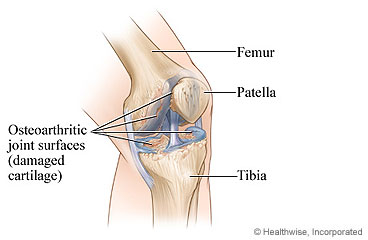
What is a total knee replacement?
A total knee replacement replaces the worn ends of the thighbone (femur) and the lower leg bone (tibia) where they meet at the knee. Sometimes the surface of the patella (kneecap) is replaced too. You may want this surgery if you have knee pain, stiffness, swelling, or problems moving your knee that you cannot treat in other ways. For most people, these problems are caused by arthritis. They can also be caused by a knee injury.
If you need to have both knees replaced, you may have both surgeries at the same time. Or your doctor may recommend doing one knee at a time. Your doctor would replace the second knee after you recover from the first knee surgery. Recovery after a double knee replacement takes longer than after a single replacement.
How is a total knee replacement done?
Before surgery, you will get medicine to make you sleep or feel relaxed. If you will be awake during surgery, you will also get a shot of medicine into your spine to make your legs numb.
There are two types of replacement joints. They are:
- Cemented joints. The cement acts as glue, attaching the new joint to the bone.
- Uncemented joints. These have a metal coating with many small openings. Over time, new bone grows and fills up the openings. This new bone attaches the joint to the bone.
Your doctor may also use a combination of cemented and uncemented parts.
Your doctor makes a cut, called an incision, on the front of your knee. Your doctor then:
- Replaces the damaged part of your femur with a metal piece.
- Replaces the damaged part of your tibia with a metal piece and plastic surface.
- May replace part of your kneecap with plastic.
The doctor finishes the surgery by closing your incision with stitches, staples, skin glue, or tape strips.
What can you expect as you recover from total knee replacement surgery?
Your knee will be swollen and will hurt when you move it. You'll need to take pain medicine for a time after surgery. Most people will start to walk with a walker or crutches the day of surgery.
You'll start rehabilitation (rehab) before you leave the hospital. Rehab will help you improve strength and movement in your knee.
You may need some extra support or help at home for the first few weeks.
After you recover, you should be able to do activities such as go for walks, dance, and ride a bike on flat ground. Talk to your doctor about whether you can do more strenuous activities.
Follow-up care is a key part of your treatment and safety. Be sure to make and go to all appointments, and call your doctor if you are having problems. It's also a good idea to know your test results and keep a list of the medicines you take.
Where can you learn more?
Go to http://www.healthwise.net/patientEd
Enter A781 in the search box to learn more about "Learning About Total Knee Replacement Surgery".
Current as of: July 17, 2023
Author: Healthwise Staff
Clinical Review Board
All Healthwise education is reviewed by a team that includes physicians, nurses, advanced practitioners, registered dieticians, and other healthcare professionals.

